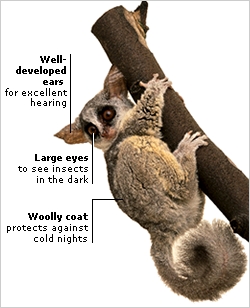DK Science: Behaviour Cycles
Animals have many instinctive behaviours that are linked to climate. Seasonal changes trigger journeys known as migrations. Populations of animals move from one area to another and back again. They may cover thousands of miles to find food or to breed. Other animals stay put during harsh weather, entering a phase of DORMANCY. Some creatures are active at night and others during the day.

Nocturnal creatures, such as this galago, which lives in the forests of Sengal, Africa, are adapted to living in the dark. During the day this small animal would be vulnerable to attack from predators, and would have to compete with many other insect-eaters. By sleeping away the daylight hours and hunting at night, it avoids these problems.
In summer, reindeer eat and put on as much weight as possible to see them through the harsh winter. They move about continually, grazing in one area before moving on to a fresh patch. With the first heavy fall of snow in autumn, they migrate southward to their winter feeding grounds, where the weather is milder and food more easily accessible. In spring, the females lead the way back to northern lands.
Salmon live most of their lives at sea, but return to the streams where they were born to spawn (produce eggs). How they find these streams is uncertain, but it is thought they use their sense of smell to navigate. The effort of swimming upstream and spawning exhausts the fish and few survive to make the journey back.
As summer moves into autumn, the days shorten, and birds such as snow geese gather in large numbers before migrating to warmer climates. Some birds are able to fly vast distances non-stop to their destinations. Birds navigate using the Sun and stars, and familiar landmarks, such as rivers and coastlines.
Each year, up to 100 million monarch butterflies migrate south from all over the USA to the relative warmth of California or Mexico. Falling temperatures in late summer trigger the migration as they cannot fly at temperatures below 12.8°C (55°F). At their winter roosts, they cluster together for warmth, each butterfly hanging its wings over the one below.
Hibernation is a form of dormancy (inactivity) in which animals build up body reserves to sustain them through winter. They enter a deep sleep and their body systems slow right down. In torpor, another form of dormancy, animals become sluggish, but are easily aroused. In aestivation, animals retreat into sand or mud burrows during dry seasons, until rain returns.
Spade-foot toads survive periods of drought by digging a burrow deep in the ground. They can bury themselves over a metre down before shedding several layers of skin to make a covering that stops them from drying out. They remain safely cocooned until it rains again. The increase in moisture causes the protective covering to break open and the toads dig their way back to the surface.
Dormice lay down fat so they can survive their long period of hibernation – up to 7 months for European species. Before winter they eat huge quantities of seeds and berries. At other times of the year they eat insects as well as berries. The change in their diet makes them sleepy and ready to hibernate. During the end of their hibernation, they rouse occasionally and begin to come out of their deep sleep. As soon as dormice wake up they mate.
